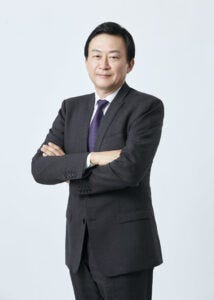
As Samsung Biologics secures land to potentially build four more biomanufacturing plants, CEO John Rim claims the CDMO can design, construct and validate a facility “probably 40% faster” than others.
In 2017, I spoke with TH Kim, the founder and then CEO of Samsung Biologics, who told me his plans to grow the contract development and manufacturing organization’s (CDMO) presence through a third facility at its site in Songdo, Korea to feed the continued demand for third-party biomanufacturing.
Five years on, and that third plant is both online and fully utilized. Meanwhile, a fourth ‘super-plant’ is close to being operational on the site, a fifth plant is in its planning stages, and a second bio campus that could house four more plants is in the works after a 426 billion Korean won ($326 billion) acquisition of a 357,000 square-meter site in Songdo was finalized this week.

The CDMO has also had a change in direction, with John Rim taking over from Kim in December 2020. Rim sat down with me at the recent BIO event in San Diego to explain the rationale behind the rapid growth strategy of his company.
“At this point in time, we have three facilities,” he began. “We have a 30,000 L facility, we have a 154,000 L plant, and we have one with 180,000 L. And they’re all full. So, we’ve started construction on plant 4 [construction of which began in November 2020] and we will have the first phase [operational] in October. So that’s two years. I mean, that’s phenomenal. Two years, 24 months – I would say there’s nowhere in the world that’s going to have a facility up and running in two years.”
Plant 4’s rapid first phase coming online – 60,000 L of the total planned 256,000 L of mammalian production capacity – is made more impressive due to the decision to used fixed-bed stainless steel equipment. According to Rim, this speed is testament to the core capability of parent company Samsung.

Samsung Biologics CEO, John Rim
“There’s no company in the world that can build facilities faster than Samsung and that really comes down to the Samsung DNA,” he said, citing the firm’s history of building multi-billion-dollar facilities in the semiconductor space.
“Having that track record, having that experience, enables us to do simultaneous construction at the same time. In record time [we do] engineering, procurement, construction, validation […] facility ramp-up to GMP, probably 40% faster than all our competition. So that’s been spectacular,” he continued. “We are now on plant four within 10 years, and I would say there’s no one in the world who’s done that, and no one who has the biologic capability of building those facilities that quickly.”
Demand
But while speed sets the CDMO apart, the decision to embrace “the Samsung DNA of execution” really comes down to demand for large biomanufacturing capabilities from biotech and biopharma.
COVID-19 highlighted the need for third-party manufacturing like nothing before, and like others Samsung Biologics saw business boom and capacity taken in the industry’s fight against the pandemic. Revenues jumped 35% in 2021 over the year prior, and manufacturing order backlogs rose 25% to $7.5 billion, driven very much by contracts supporting anti-COVID programs from Eli Lilly, GSK and AstraZeneca. The approval of COVID vaccines also encouraged a mover into the burgeoning mRNA space, and the CDMO recently produced the first batch of drug substance for GreenLight Biosciences from a newly built mRNA facility in Korea.
However, the need for related vaccines and therapies is declining as the pandemic abates, yet Rim is not concerned. Neither is he concerned with the recent failure of Aduhelm (aducanumab), Biogen’s one-time potential Alzheimer’s blockbuster drug. (While no agreement was made public, Samsung Biologics had been widely expected to manufacture the monoclonal antibody with the previous CEO hinting of significant deals in this disease area.)
“Biogen has had lots of issues,” Rim said, “but if aducanumab had worked and it had been successful, you would need two more facilities just to probably meet 10% of the demand in Alzheimer’s because it’s a huge unmet medical need.
“Aducanumab hasn’t been successful. But you know, there’s other products that are coming online.” In the space, Eli Lilly is developing donanemab, Roche has gantenerumab, and Biogen continues to target the disease with lecanemab. “Ultimately, I think the whole neurosciences area will open up at some point […] so I do see huge potential opportunities for growth continuing.”
Beyond Korea
Samsung Biologics recently took its first geographical step outside Korea, opening an R&D in the San Francisco area. However, as apparent from current construction projects and the forthcoming bio campus 2, manufacturing investments for now remain in Korea.
But this was not a deliberate attempt to stay within Samsung Biologics’ native country, Rim said, especially as most of the CDMO’s customers are from outside of Korea (90%, mostly from the US and Europe).
He added the firm looked at both greenfield and brownfield sites both in the US and Korea before settling on Songdo for plant 4. “What we came to at that time, was that the speed to construct the facility and get it up and running was much more secure in Korea than it was in the United States.” There was a pandemic underway at the time, he continued, “and so we made the decision then to really build plant 4 for in Korea. And I think in retrospect, it was the right decision.”
Again, Rim stressed that speed was the key driver. “The speed to construction, speed to be able to ramp up,” he said. “If we had built in the United States, for example, I don’t think we would have an operation up and running October this year. We would not have that capacity. I firmly believe that.”
But that does not mean future investments will remain in Korea, as the firm continues to evaluate opportunities elsewhere.
“We do look at expansion opportunities, and we have looked at both purchasing, as well as greenfield construction. Samsung has two semiconductor large semiconductor facilities in Texas; they also have a huge appliance facility in South Carolina. So it’s not that we don’t have facilities in the United States. We do have, but [for Biologics] it’s trying to figure out what’s the right timing.”
Again, the pandemic stoked up notions of in-region manufacturing, which somewhat factors in future plans for what is essentially, for now, a one-site global CDMO.
“Some of the supply chain management issues now, I think, are a result of nationalistic behavior and trying to put facilities more geographic proximity. And I do think that trend will be there, but it also means you start to lose some of your flexibility on cost, and you lose some of your flexibility on speed.”
However, he said: “We will definitely be in the United States and Europe at some point,” though added it will come down to the right timing and the right opportunity.
About the Author
You May Also Like

schedl_b_and_w.jpg?width=100&auto=webp&quality=80&disable=upscale)
schedl_b_and_w.jpg?width=400&auto=webp&quality=80&disable=upscale)



